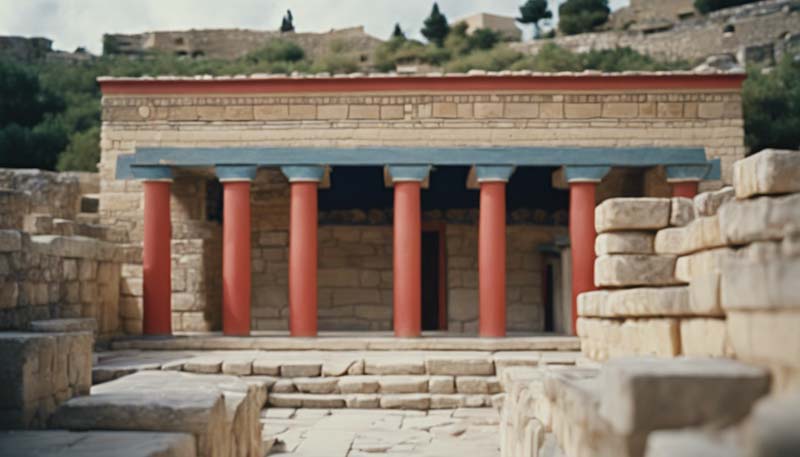The Palace of Knossos: Unraveling the Secrets of the Minoans
The Palace of Knossos is a site of immense archaeological significance, situated in the heart of Crete, an island in the southern part of the Aegean Sea. It is the most prominent symbol of the Minoan civilization, which is believed to have flourished between approximately 2600 and 1125 BCE. The palace is a monumental structure that has captivated historians, archaeologists, and tourists alike with its enigmatic past and the rich cultural heritage it represents.
Introduction to the Minoan Civilization
The Minoans are named after the legendary King Minos, a mythological figure associated with the labyrinth and the mythical creature, the Minotaur. They are considered the first advanced European civilization, with a culture that was sophisticated and dynamic, characterized by remarkable achievements in art, architecture, and social organization. The civilization's influence extended across the Aegean Sea and played a significant role in the development of the ancient world.
Advertisement
The Discovery of Knossos
The rediscovery of the Palace of Knossos is largely credited to the British archaeologist Sir Arthur Evans, who began excavations in 1900. The site had been known before, but Evans' work uncovered the vast extent and complexity of the palace, revealing a civilization that had been lost to history for over three millennia.
Evans' Methodology and Reconstruction
Evans' approach to archaeology was both innovative and controversial. He meticulously documented his findings but also reconstructed many parts of the palace, sometimes using modern materials and informed speculation. While these reconstructions have been criticized for potentially distorting the historical record, they also serve as a testament to the grandeur of the original structures and have contributed to the public's fascination with the Minoans.
Architecture and Layout
The Palace of Knossos is an architectural marvel, covering an area of approximately 215,000 square feet. Its design is characterized by a complex layout with numerous rooms, corridors, and staircases, which has led to its description as a "labyrinth." The palace's architecture reflects a high level of technical skill, including advanced drainage systems, pottery workshops, and evidence of multi-story structures.
Significant Features
Among the most notable features of the palace are the central courtyard, the Throne Room with its distinctive alabaster throne, and the frescoes that adorn the walls. The frescoes depict scenes from daily life, religious ceremonies, and nature, providing a window into the Minoan aesthetic and their connection with the natural world.

Religion and Culture
The Minoans were polytheistic, and their religion played a central role in their culture. The Palace of Knossos is replete with religious iconography, including depictions of a snake goddess, which is a recurring motif in Minoan art. The significance of the snake in Minoan culture is still a subject of debate, with theories ranging from a symbol of fertility to a representation of a priestess's divine power.
Minoan Art and Pottery
Minoan art is renowned for its naturalism and vibrant colors. The frescoes and pottery found at Knossos are evidence of a highly developed artistic tradition. Pottery was not only functional but also decorative, with scenes of flora, fauna, and daily life painted onto the surfaces. The skill of Minoan potters was exceptional, and their wares were traded across the Mediterranean.
The Minoan Script and Language
Minoan civilization is associated with two scripts: Linear A and Linear B. Linear A has yet to be deciphered, while Linear B, discovered at Knossos, is an early form of Greek. The ability to read Linear B has shed light on the administrative practices of the Mycenaean Greeks but has left the Minoan language and script shrouded in mystery.
Decline and Fall
The decline of the Minoan civilization is still not fully understood. Theories include natural disasters, such as earthquakes or volcanic eruptions, as well as invasions by the Mycenaeans from mainland Greece. The final destruction of the palace at Knossos is believed to have occurred around 1375 BCE, marking the end of the Minoan era.
Legacy and Modern Perceptions
The Palace of Knossos and the broader Minoan civilization have left an indelible mark on our understanding of the ancient world. They represent a pinnacle of Bronze Age culture and have influenced subsequent civilizations, including the Mycenaeans and later the classical Greeks. Today, the site continues to be a source of fascination and research, offering a glimpse into a sophisticated and enigmatic past.
Tourism and Preservation
As a major tourist attraction, the Palace of Knossos faces the challenge of preserving its historical integrity while accommodating visitors. Efforts are underway to balance conservation with the public's desire to experience this ancient wonder. The site is a UNESCO World Heritage Site, highlighting its importance to global cultural heritage.
Conclusion
The Palace of Knossos stands as a testament to the Minoans' ingenuity and cultural achievements. Despite the many mysteries that still surround this ancient civilization, the palace provides a tangible link to a time of remarkable artistic and architectural innovation. As archaeologists continue to uncover new insights and as technology advances, we can expect to learn even more about the Minoans and their place in history.
Further Reading:
Comments